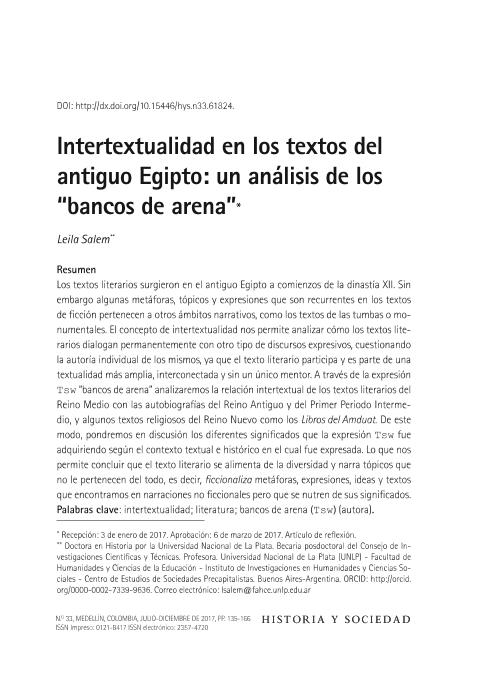Mostrar el registro sencillo del ítem
dc.contributor.author
Salem, Leila Salem

dc.date.available
2018-11-23T19:04:02Z
dc.date.issued
2017-06
dc.identifier.citation
Salem, Leila Salem; Intertextualidad en los textos del antiguo Egipto: un análisis de los “bancos de arena”; Universidad Nacional de Colombia (Sede Medellín). Facultad de Ciencias Humanas y Económicas. Departamento de Historia; Historia y Sociedad; 33; 6-2017; 135-166
dc.identifier.issn
0121-8417
dc.identifier.uri
http://hdl.handle.net/11336/65053
dc.description.abstract
Los textos literarios surgen en el antiguo Egipto a comienzos de la dinastía XII. Sin embargo algunas metáforas, tópicos y expresiones que son recurrentes en los textos de ficción pertenecen a otros ámbitos narrativos, como los textos de las tumbas o monumentales. El concepto de intertextualidad nos permite analizar cómo los textos literarios dialogan permanentemente con otro tipo de discursos expresivos, poniendo en cuestionamiento la autoría individual de los mismos, ya que el texto literario participa y es parte de una textualidad más amplia, interconectada, y sin un único mentor. A través de la expresión Tsw "bancos de arena" analizaremos la relación intertextual de los textos literarios del Reino Medio con las autobiografías del Reino Antiguo y el Primer Periodo Intermedio y algunos textos religiosos del Reino Nuevo como los Libros del Amduat. De este modo, se pondrán en discusión los diferentes significados que la expresión Tsw fue adquiriendo según el contexto textual e histórico en el cual es expresada. Lo que nos permite concluir que el texto literario se alimenta de la diversidad y narra tópicos que no le pertenecen del todo, es decir ficcionaliza metáforas, expresiones, ideas, textos que los encontramos en narraciones no ficcionales pero que se nutre de sus significados.
dc.description.abstract
Literary texts emerged in ancient Egypt at the beginning of the 12th Dynasty. Nevertheless some metaphors, topics and expressions that are recurrent in the texts of fiction belong to other narrative fields, like the texts of the tombs or monumental. The concept of intertextuality allows us to analyze how literary texts permanently dialogue with other types of expressive discourses, putting in question the individual authorship of the same, since the literary text participates and is part of a broader, interconnected textuality, without a single mentor. Through the expression Tsw "sandbanks" we will analyze the intertextual relationship of the literary texts of the Middle Kingdom with the autobiographies of the Ancient Kingdom, and the First Intermediate Period and some religious texts of the New Kingdom as the Books of the Amduat. In this way, we will discuss the different meanings that the expression Tsw was acquiring according to the textual and historical context in which it was expressed. This allows us to conclude that the literary text is nourished by diversity and narrates topics that do not entirely belong to it, that is, it fictionalizes metaphors, expressions, ideas, texts that we find in nonfiction narratives but which are nourished by their meanings.
dc.format
application/pdf
dc.language.iso
spa
dc.publisher
Universidad Nacional de Colombia (Sede Medellín). Facultad de Ciencias Humanas y Económicas. Departamento de Historia
dc.rights
info:eu-repo/semantics/openAccess
dc.rights.uri
https://creativecommons.org/licenses/by-nc-nd/2.5/ar/
dc.subject
Intertextualidad
dc.subject
Literatura
dc.subject
Bancos de Arena (Tsw)
dc.subject.classification
Historia

dc.subject.classification
Historia y Arqueología

dc.subject.classification
HUMANIDADES

dc.title
Intertextualidad en los textos del antiguo Egipto: un análisis de los “bancos de arena”
dc.title
Intertextuality in the texts of Ancient Egypt: an analysis of the "sandbanks"
dc.type
info:eu-repo/semantics/article
dc.type
info:ar-repo/semantics/artículo
dc.type
info:eu-repo/semantics/publishedVersion
dc.date.updated
2018-10-22T20:17:57Z
dc.identifier.eissn
2357-4720
dc.journal.number
33
dc.journal.pagination
135-166
dc.journal.pais
Colombia

dc.journal.ciudad
Medellín
dc.description.fil
Fil: Salem, Leila Salem. Universidad Nacional de La Plata. Facultad de Humanidades y Ciencias de la Educación. Centro de Estudios de Sociedades Precapitalistas; Argentina. Consejo Nacional de Investigaciones Científicas y Técnicas. Centro Científico Tecnológico Conicet - La Plata. Instituto de Investigaciones en Humanidades y Ciencias Sociales. Universidad Nacional de La Plata. Facultad de Humanidades y Ciencias de la Educación. Instituto de Investigaciones en Humanidades y Ciencias Sociales; Argentina
dc.journal.title
Historia y Sociedad
dc.relation.alternativeid
info:eu-repo/semantics/altIdentifier/doi/http://dx.doi.org/10.15446/hys.n33.61824
dc.relation.alternativeid
info:eu-repo/semantics/altIdentifier/url/http://ref.scielo.org/qb5vmb
dc.relation.alternativeid
info:eu-repo/semantics/altIdentifier/url/https://revistas.unal.edu.co/index.php/hisysoc/article/view/61824
Archivos asociados
